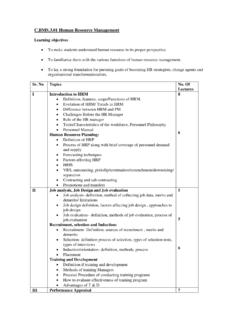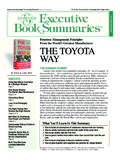Transcription of 1. Design for excellence – quality control & DFX
1 Open Access Library Volume 6 (12) 2012. 1. Design for excellence quality control & DFX. Introduction The Design and manufacturing processes as well as their quality control and operation management at the beginning of the industrial era were in the hands of a lone person, the craftsman, as a handcraft activity. Design and manufacturing and their quality control and management changed with the beginning of that era, which occurred more than two centuries ago in England, with the invention of the steam machine, and the mechanical loom for weaving, which is known today as the first industrial revolution. In this sense Design and manufacturing, a transformation operation process should be studied joining the aspects of materials, manufacturing and management , as postulated in the Figure A historical evolution of this synergy between Design , manufacturing and management can be seen at Table , complemented by the more recent approaches including a continuous improvement of the quality of product and processes (Figure ), emphasized on the purpose of this book of a Design of excellence approach for the development of product and manufacturing processes.
2 In this sense, Design and manufacturing quality control and management are different now. The search for increasing quality levels turned to new methods for improving processes, such as integration with CIM (Computer Integrated Manufacturing) and Lean Manufacturing (LM). and Six Sigma (6j), called Lean Six Sigma (L6j) (see Table ). Figure Schematic of a production system [1]. 8 Batalha Design for X Design for excellence Table Historical evolution of the manufacturing & operational management (Adapted [1]). Date Contribution Contributor 1776 Specialization of labour in manufacturing Adam Smith 1799 Interchangeable parts, cost accounting Eli Whitney & others Division of labour by skill; assignment of jobs by 1832 Charles Babbage skill; basics of time study 1898 Scientific management time study and work study Karol Adamiecki 1900 Developed dividing planning and doing of work / Frederick W. Taylor 1900 Motion study Frank B. Gilbreth Scheduling techniques for employees, machines jobs 1901 Henry L.
3 Gantt in manufacturing 1915 Economic lot sizes for inventory control Harris 1916 General Theory of the Operational management K. Adamiecki/ Henri Fayol 1927 Human relations; the Hawthorne studies Elton Mayo Statistical inference applied to product quality : 1931 Shewart quality control charts Statistical Sampling applied to quality control : 1935 Dodge & H. Roming inspection sampling plans 1940 Operations research applications in World War II Blacker & others 1946 Digital Computer John Mauchlly & J. Eckert 1947 Linear Programming G. Dantzig, Williams & ot Mathematical programming, non-linear and A. Charnes, Cooper 1950. stochastic processes & others Commercial digital computer: large-scale 1951 Sperry Univac computations available 1960 Organizational behaviour: study of people at work L. Cummings, L. Porter 1968 Metrological terminology standardization J. Obalski & J. Oderfeld Overall strategy integrating operations - Computer W. Skinner J. Orlicky &. 1970 integrated manufacturing (CIM), scheduling and G.
4 Wright control , Material Requirement Planning (MRP). quality & productivity applications from Japan: 1980 Deming & J. Juran robotics, CAD-CAM, Toyota quality system Table Methodologies to support quality System in product Design and manufacturing [2]. No Acronym Explanation CIM Computer Integrated Manufacturing & Design For Manufacturing 1. DFMA & Assembly Lean Manufacturing = Waste elimination & lead-time reduction. 2. LM. VSM Value Stream Mapping , 5S's & PokaYoke Six Sigma Zero defects & customer satisfaction. DMAIC (Define, Measure, 3. (6 ) Analyse, Improve, control ). 1. Design for excellence quality control & DFX 9. Open Access Library Volume 6 (12) 2012. The conception of a continuous improvement integrated quality control system for the management during product Design and manufacturing, however a complex task, as shown by the factors illustrated on the Figure The recent increase of possibilities of the information technology (IT) enables the designers and R&D managers to face the challenge to balance all these factors using a simultaneous and concurrent engineering approach.
5 This approach is very useful, especially when it is applied to the historical evolution of the complexity and quantity of components of new products, as well as to the versatile and enhanced range of the available engineering materials and manufacturing processes (See Figure ). Chronologically increasing of the number of components as well as of the mass of the new car bodies can be justified by several new improvements likes: hybrid power trains, automatic transmission, active suspension, freely configurable inner space, on board navigation systems Figure Integrated factors influencing the product research and development [3-4]. 10 Batalha Design for X Design for excellence Figure The increase in complexity of parts from the industrial revolution onward (After[5]). Figure Chronologically increasing weight of cars introduced in the market. Adapted from Automobil industrie, 9, 2009, [6-7]. 1. Design for excellence quality control & DFX 11. Open Access Library Volume 6 (12) 2012. (GPS & multimedia), pre-crash sensors, active curve lights (headlamps), pedestrian protection, night vision and field recognition, car to car communication, etc.
6 (see Figure ). In agreement with these points, the development of this book was directed by the following research question: how to implement the integration of CIM and L6 which are different methodologies to attain the improvement of systems performance within an implementation for this approach by involving technical and human resources and approaches of Design for excellence (DFX)? Although this is an issue caused by the manufacturing companies, the application of L6 can also be extended to the improvement of administrative processes and services [8]. However, the choice here was to restrict the boundaries of research to exploit the conditions in which the L6 has been used in the improvement of quality systems in industrial processes to obtain more specific results. This chapter is structured as follows. Initially, section presents a theoretical framework on the CIM, LM and 6 methodologies. Then, a case study on the implementation of the approach of integration CIM and LSS, with its organizational aspects are addressed in Section In section , the case is examined in the light of the research issue and finally, in section the conclusions are presented.
7 CIM and Lean Six Sigma Computer Integrated Manufacturing The acronym CIM Computer Integrated Manufacturing is the Computer (C) which plans, organizes and simplifies all decisions at all levels of an organization by Integrated (I) that connects all computers and systems within a comprehensive communication plan, besides the Integration activity (I) and Manufacturing (M) that establishes a manufacturing organization in its broad form, or as a strategic business unit. In CIM, the integration initially takes place with the CAD/CAM, which was subsequently developed with other methodologies, including DFMA ( Design for Manufacturing and Assembly) [9]. CAD (Computer Aided Design ) and CAM (Computer Aided Manufacturing) form the CAD/CAM pronounced together as an integrated system [10]. Figure illustrates the different methodologies that can be integrated under the acronym CIM . 12 Batalha Design for X Design for excellence Figure The different components of a computer integrated manufacturing approach, (adapted from sparse notes from RWTH lectures [10]).
8 The growing need to produce better quality goods with lower costs have made companies move towards integration and industrial automation. Automation is invading areas such as trade, banking, office, education, agriculture and industry. However, the execution of that search is planned and organized. Therefore, it requires creativity at first and then, investments, requiring it to be ordered and supported by a methodology and by an action plan. The CIM should support the business strategy which, in turn, studies the behaviour of the market and how the company should market the product. However, both strategies are about whether this methodology also depends on the human factor in relation to the achievement of goals through organizational structures. The integration of the client, the product and process Project Design can be aided by QFD. ( quality Function Deployment), which is a technique used to transmit the customer needs for engineering the product, aiming to facilitate engineering and manufacturing planning.
9 This unfolding identifies causes, defines tasks and suggests methods to find the product "designed". by the client. The QFD is a concept similar to the DFM ( Design for Manufacturing) because it also seeks to integrate communication between the product engineering, quality , marketing 1. Design for excellence quality control & DFX 13. Open Access Library Volume 6 (12) 2012. and customer. Still, the QFD drives the designers of the product to compare a range of technical information as well as business data so that they can choose, together with marketing, which ones fit the need of the customer. The QFD technique reduces the total time of project, and the DFM. The DFM, also included in the approach as SE - Simultaneous Engineering, or CE . Concurrent Engineering is the concomitant development of the project functions of the product and process, which aims to reduce cost and time to launch the product in the market. Applying this techniques yields feasibility to obtain a quality product that can be introduced with enhanced productivity and manufacturing, since it takes into account the entire production system during the development of this project [9].
10 DFM means increased joint work of product and processes engineers with the staff of the "factory shop-floor" and provides more commu- nication, cooperation and integration. In many traditional organizations, the engineering of the product aims first at terminating the project, drawings, calculations and prototypes, and only then releasing all the engineering drawings for the process, which once being in possession of drawings of products, may establish a roadmap for manufacturing, specifying the machines, choosing the tools and work stations. During this phase, analysis of cost and feasibility often create the need to request changes in the product but, at this point, the analysis of these changes becomes difficult and sometimes impossible, leading to an additional product, an increase in manufacturing time and the need for certain operations in the process that could have been avoided [9]. As a result, simultaneous engineering aims to develop the Design of product/process avoiding all instances mentioned above.








